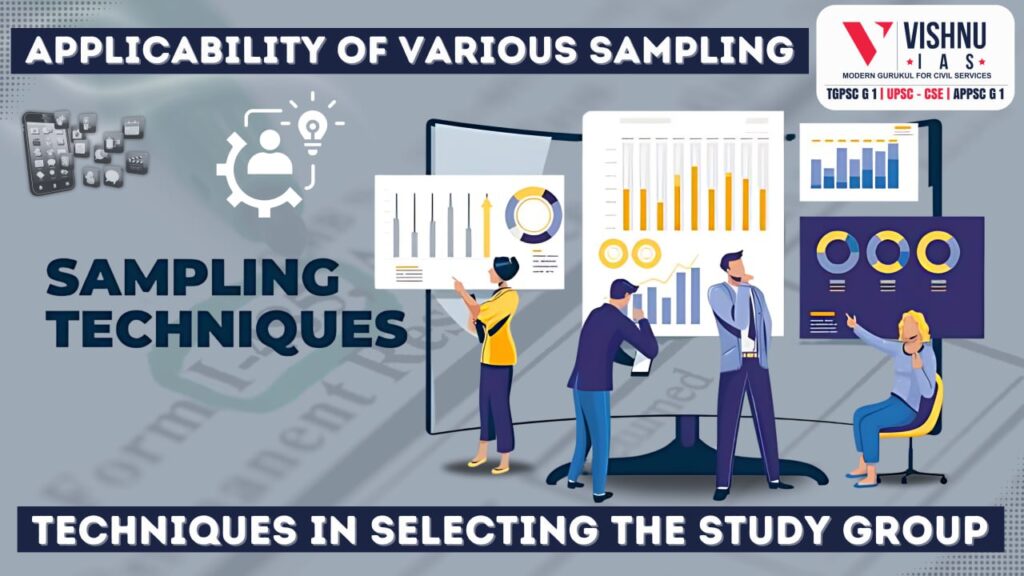Various Sampling Methods and Techniques
- Introduction: add few points about the sampling techniques
- Body: add the comprehensive analysis about the applicability of various sampling techniques in selecting the study group with present challenges and limitations.
- Conclusion: add its contemporary relevance
INTRODUCTION
- Selecting an appropriate sampling technique is crucial for ensuring that the study group accurately represents the target population. Different sampling methods have their own advantages and limitations, making them suitable for various research contexts.
BODY
Applicability of Various Sampling Techniques in Selecting the Study Group
Here’s a comprehensive overview of the main sampling techniques and their applicability:
- Probability Sampling Methods
- Probability sampling involves random selection, allowing each member of the population an equal chance of being included in the sample. This method minimizes selection bias and enhances the generalizability of the results.
- Simple Random Sampling
- Description: Every member of the population has an equal chance of being selected.
- Applicability: Ideal for homogeneous populations where each member is similar in terms of the characteristics being studied.
- Example: Drawing names from a hat to select participants for a study on dietary habits among university students.
- Stratified Sampling
- Description: The population is divided into subgroups (strata) based on specific characteristics (e.g., age, gender), and random samples are drawn from each stratum.
- Applicability: Useful when the population has distinct subgroups and the researcher wants to ensure representation from each subgroup.
- Example: Studying the impact of a new teaching method across different grade levels in a school.
- Cluster Sampling
- Description: The population is divided into clusters (e.g., geographical areas), and entire clusters are randomly selected.
- Applicability: Effective for large, geographically dispersed populations where it is impractical to sample individuals directly.
- Example: Conducting a health survey by randomly selecting and surveying entire villages in a rural area
- Systematic Sampling
- Description: Every nth member of the population is selected after a random starting point.
- Applicability: Suitable for ordered populations where a systematic approach can simplify the sampling process.
- Example: Selecting every 10th patient from a hospital registry to study patient satisfaction1.
- Non-Probability Sampling Methods
- Non-probability sampling involves non-random selection based on convenience or other criteria. While easier to implement, it may introduce bias and limit the generalizability of the results.
- Convenience Sampling
- Description: Participants are selected based on their availability and willingness to take part.
- Applicability: Useful for exploratory research or when quick, easy access to participants is needed.
- Example: Surveying shoppers at a mall to gather opinions on a new product.
- b. Purposive (Judgmental) Sampling
- Description: Participants are selected based on specific characteristics or criteria set by the researcher.
- Applicability: Suitable for studies requiring expert opinions or specific cases.
- Example: Interviewing experienced teachers to understand challenges in remote education.
- c. Snowball Sampling
- Description: Existing participants recruit future participants from among their acquaintances.
- Applicability: Effective for hard-to-reach or hidden populations.
- Example: Studying the experiences of undocumented immigrants by asking participants to refer others.
- d. Quota Sampling
- Description: The population is divided into subgroups, and a specific number of participants are selected from each subgroup based on convenience.
- Applicability: Ensures representation of key subgroups without random selection.
- Example: Ensuring equal representation of men and women in a market research study4.
CONCLUSION
- The choice of sampling technique depends on the research objectives, the nature of the population, and practical considerations such as time, resources, and accessibility. Probability sampling methods are generally preferred for their ability to produce representative and generalizable results, while non-probability sampling methods are useful for exploratory research and specific contexts where probability sampling is impractical.
Anthropology Full Course at Vishnu IAS Academy
What does Course Offer?
- 4 Months (250+ Class Hours)
- Online (App + Web) / Offline / Hybrid Mode of Classes
- Live + Recorded Videos Access For 1 Year
- 2 Hour Live Class From Monday to Saturday (1.5 Hours for Class + ½ Hour for Doubt Solving)
- Foundation to Advanced Level of Teaching
- Simple and Integrated Content
- One Stop Solution Books
- Regular Value Added Content
- Current Affairs & Case Studies Modules
- Daily Answer Writing Practice
- Weekly Grand Tests On Sundays & Evaluation With Guidance and Topper Will be Rewarded
- 500+ Model Answers
- 9 AM – 9 PM Support System
- Free GS Current Affairs
- Free Interview Guidance for Anthropology
Here at Vishnu IAS, we provide a comprehensive coverage of Complete Anthropology Syllabus For UPSC Preparation so that students function with the clarity needed to navigate the course of optional preparation for scoring 300+ marks.


